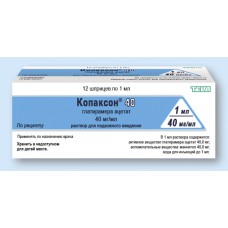Expiration date: 01/2026
Dosage form
Slightly opalescent solution from colorless to light yellow color
Composition
1 ml of solution contains: active substance glatiramer acetate 40,0 mg; excipients: mannitol 40.0 mg. water for injection to 1 ml.
Pharmacological action
The mechanism of action of glatiramer acetate in patients with multiple sclerosis not until the end studied. I believe that glatiramer acetate modifies immune processes, presumably playing a major role in the pathogenesis of multiple sclerosis. This hypothesis is confirmed by the results of studies conducted to explore the pathogenesis of experimental allergic encephalomyelitis (EAE). ???3 often used as an experimental model of multiple sclerosis. Studies conducted on animals and on patients with multiple sclerosis, showed that the introduction of glatiramer acetate induces peripheral induction and activation of the eye of example Aetat-specific suppressor T limfozitov. Retidiviruuschem-remitting multiple sclerosis
The results of a 12-month, placebo-kontroliruemoi studies confirmed
the effectiveness of the drug Copaxone 40 in a dosage of 40 mg/ml for subcutaneous injection three ease a week to reduce the frequency of exacerbations.
During registration clinical studies the inclusion criteria of patients with relapsing-remitting multiple sclerosis was at least one documented clinical exacerbation in the last 12 months, or two exacerbations in the past 24 months, or one exacerbation in the last
12 -24 months in the presence of at least one source repository for contrast (G. 1+) p visualized on T1 -weighted MRI images in the last 12 months.
Pervichnoi the aim of the study was to determine the total number of confirmed exacerbation. The secondary purpose of determining the aggregate number of new/uvelichivshie lesions. identify PA T2-weighted MRI images and the total number of lesions accumulate contrast and visualizing on TI-weighted images at the 6th and 12th month of the study.
The study was randomized 1404 patient ratio of 2:1 in the group treated with the drug Copaxone" 40 at a dose of 40 mg/ml (n=943) or placebo (n=461), respectively. Both groups had comparable baseline geograficheskim indicators, the peculiarities of multiple sclerosis and MRI parameters. Patients had a median of 2.0 exacerbations of the disease within 2 years prior to screening.
Compared with the placebo patients receiving the drug Copaxone 40 at a dose of 40 mg/ml three times a week, there was a statistically significant reduction in the frequency of exacerbations and the total number of lesions on T2-weighted images, and lesions accumulate contrast on T1-weighted images, which corresponds to the therapeutic effect of the drug Copaxon-Teva 20 mg/ml for daily injection.
Direct comparative analysis of the effectiveness and safety of the drug in a dose of 20 mg/ml (with daily administration) and 40 mg/ml (3-times weekly administration) in the framework of this research has not been conducted.
During this 12-month study provided no evidence that the effect of the drug on the progression of invalidization or duration of exacerbations.
Currently, there are no data on the use of the drug in patients with primary or secondary progressive multiple sclerosis.
Pharmacokinetics
Studies of pharmacokinetics in patients was conducted. The data in vitro, and limited data obtained in the participation of healthy volunteers show that following subcutaneous injection the active substance is rapidly absorbed, with most of it breaks into small fragments in the subcutaneous tissue.
Data preclinical study. Preclinical data based on studies of pharmacological safety, toxicity at repeated administration, reproductive toxicity, genotoxicity or Carcinogenicity. not indicate the presence of special hazards to man, other than the data already included in sections of this instruction for medical use of the drug. In the absence of data on pharmacokinetics, it is impossible to define the allowable concentration limits in humans compared to animals.
In a small number of rats and monkeys, which were injected drug at least for 6 months, it was observed the deposition of immune complexes in the renal glomeruli. 2.-year study in rats were not observed the deposition of immune complexes in the renal glomeruli.
Sensitized animals (Guinea pigs and mice) after administration of the drug were observed anaphylaxis. The relevance of these data to humans is not known. Toxic effects at the site of injection after repeated administration of the drug in animals refers to common reactions.
Side effects
CNS: asthenia, migraine, anxiety, loss of consciousness, tremor.
From the side of cardiovascular system: facial flushing, feeling of heaviness and chest pain, palpitations, arrhythmia, vasodilation, increase in blood pressure.
From the digestive system: reduced appetite, nausea, vomiting, diarrhea, difficulty swallowing, thrush.
From the senses: vertigo, nystagmus, blurred vision.
The respiratory system: shortness of breath, difficulty breathing, infection, laryngospasm bronchitis, hyperventilation.
From the reproductive system: dysmenorrhea, reduced potency.
From the urinary system: peripheral edema, hematuria, questionable test results in PAP tests.
Allergic reactions: urticaria, angioedema.
Local reactions: redness, swelling, itching, soreness at the injection site.
Other: arthralgia, lymphadenopathy, back pain, sweating, flu-like symptoms.
Testimony
Reiigious-remitting multiple sclerosis.
Contraindications
Pregnancy, lactation, childhood and adolescence to 18 years, increased sensitivity to glatiramer acetate.
Application of pregnancy and breastfeeding
Adequate and well-controlled studies safety of glatiramer acetate during pregnancy have not been conducted.
Unknown, selects whether glatiramer acetate in breast milk, so if necessary, use during lactation should stop breastfeeding.
In experimental studies revealed no mutagenic effects of glatiramer acetate and its negative effects on the reproductive system, embryonic development and the birth process.
Dosage
In the form of subcutaneous injections but 40 mg drug Copaxone 40 (one filled with the drug solution in the syringe for injection) 3 times per week, the minimum interval between injections is 48 hours. The drug is not intended for intravenous or intramuscular administration. Patients are encouraged to undergo training on the subject of self-injections. The first injection (and 30 minutes thereafter) should be under the supervision of a qualified professional. To reduce the risk of irritation or pain at the injection site each time you need to change the zone for injection. Each syringe with the drug Copaxone' 40 is for a single npi changes.





